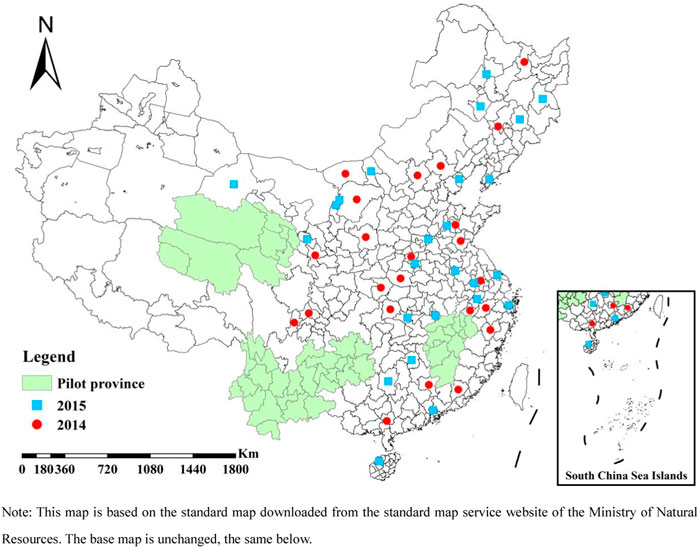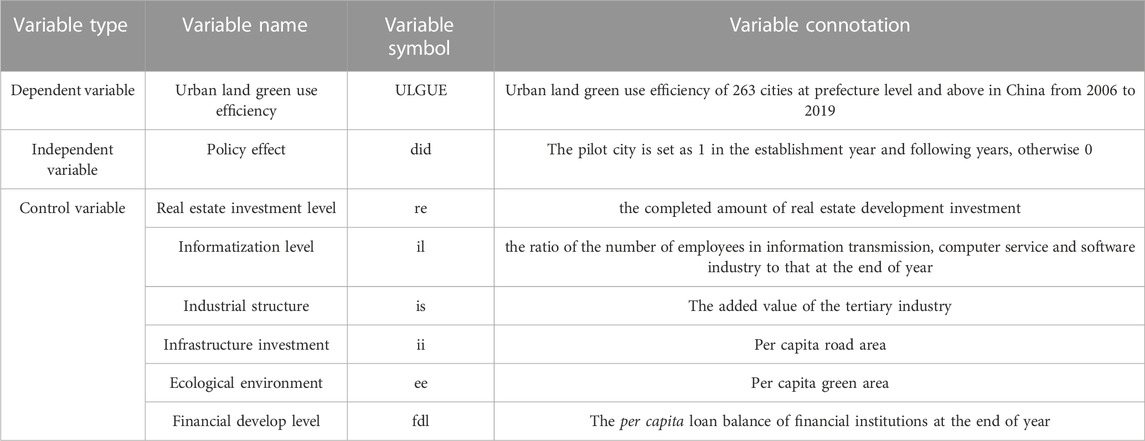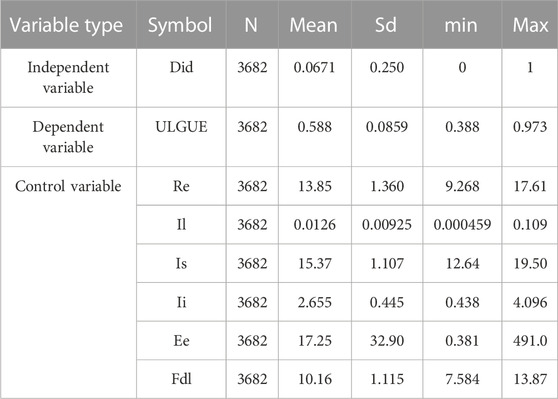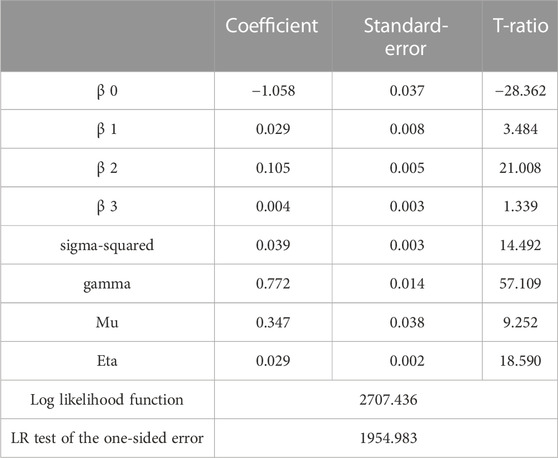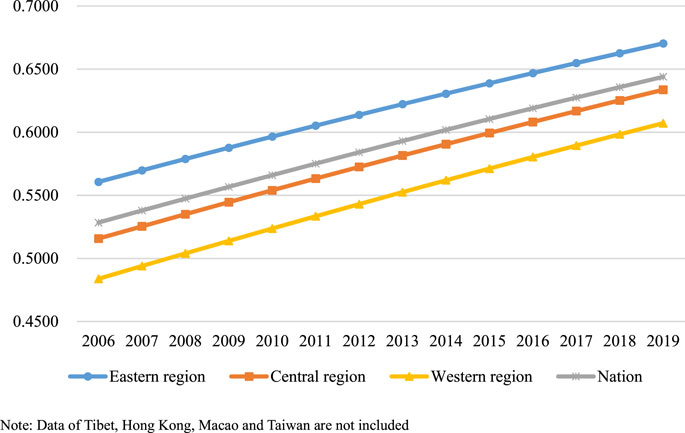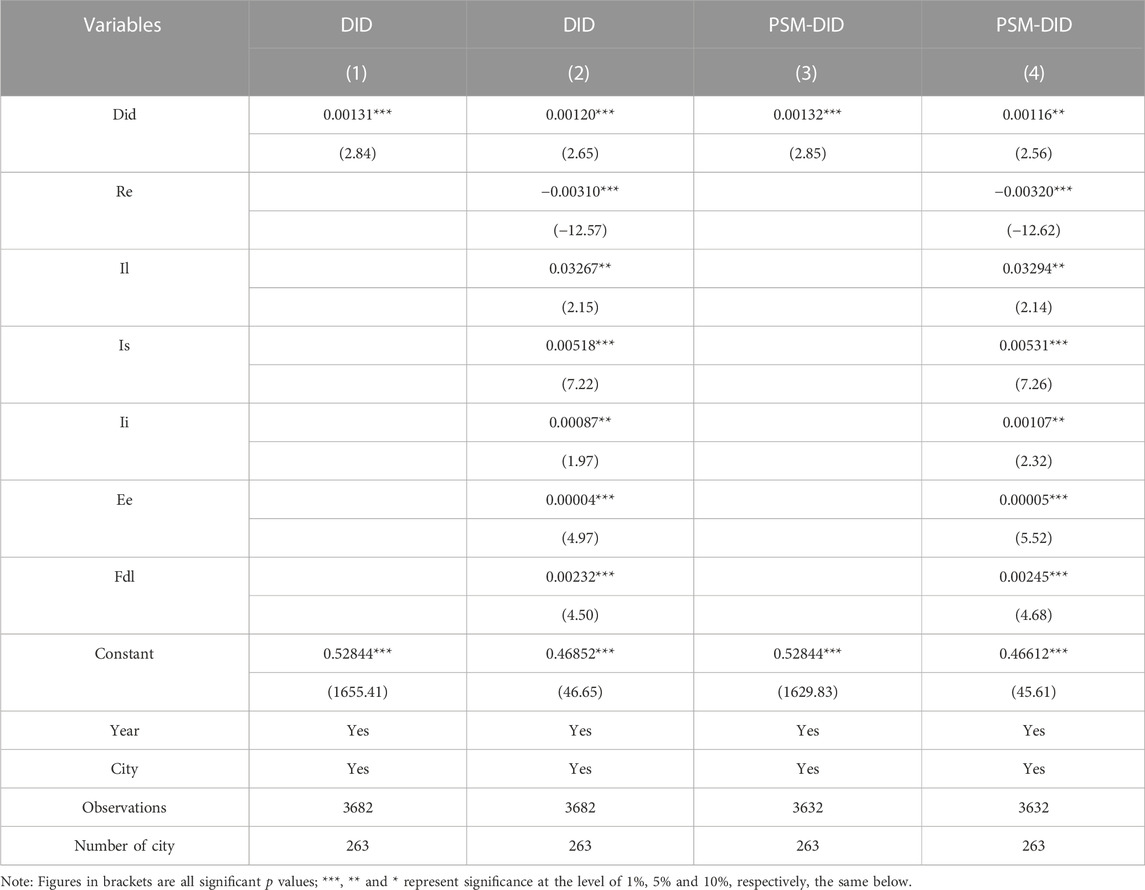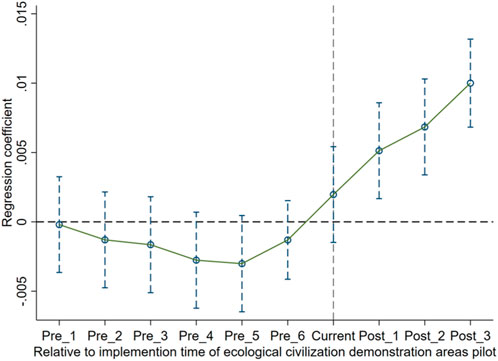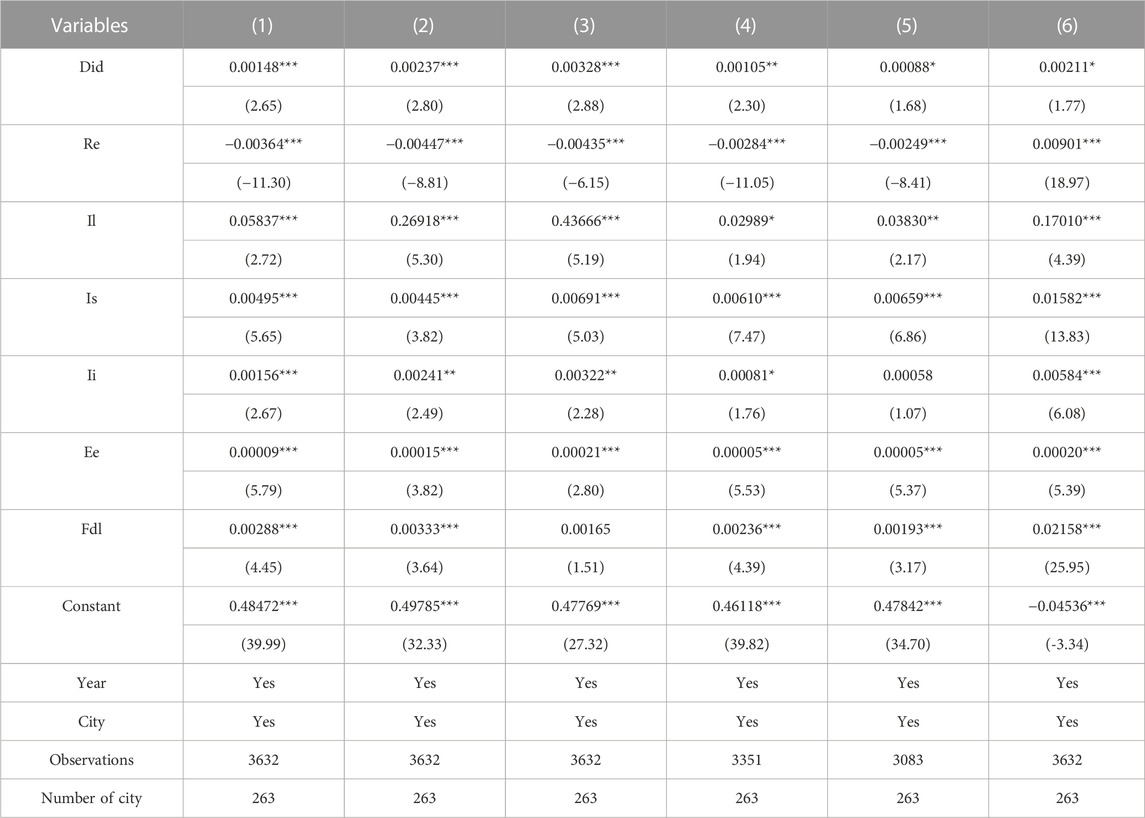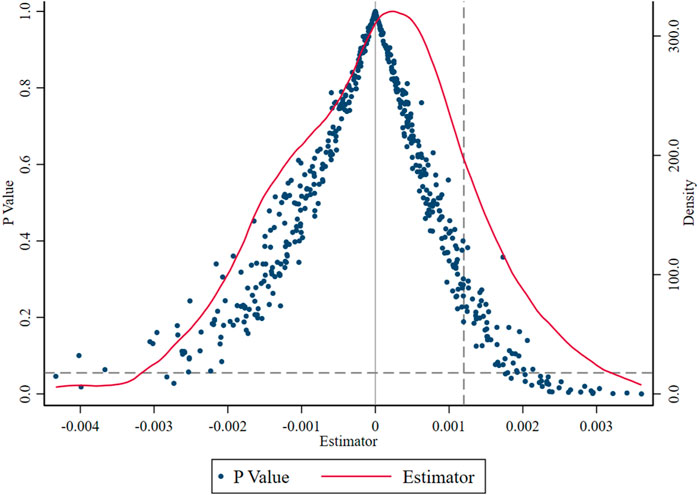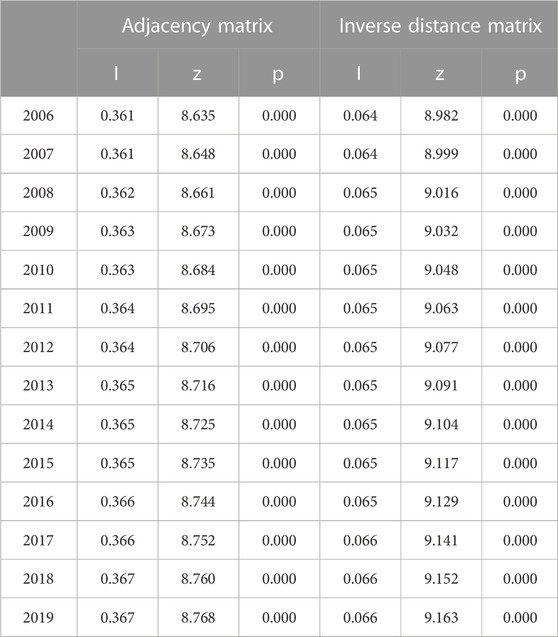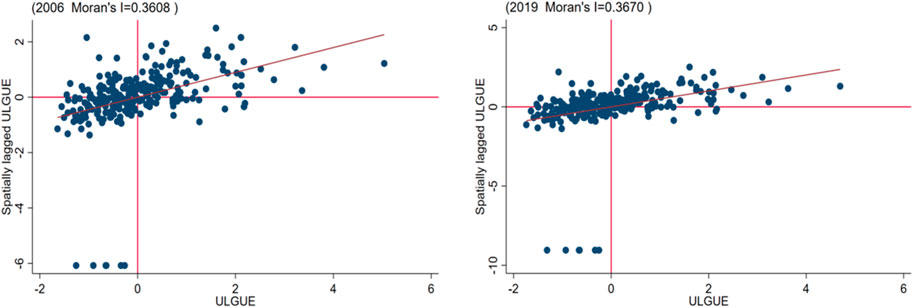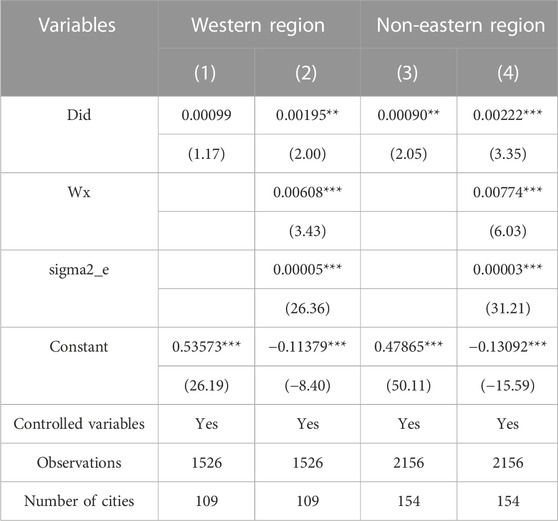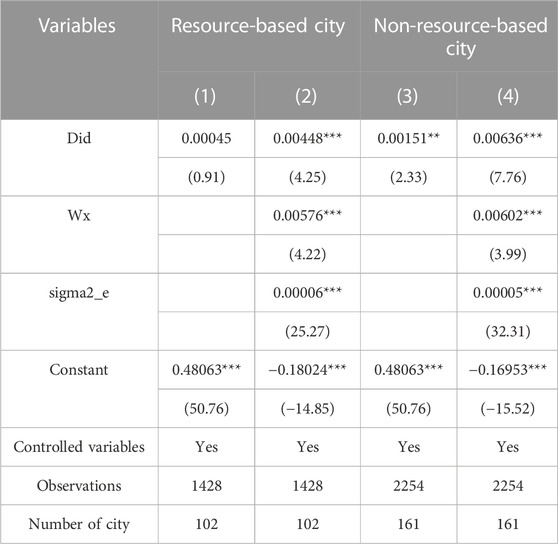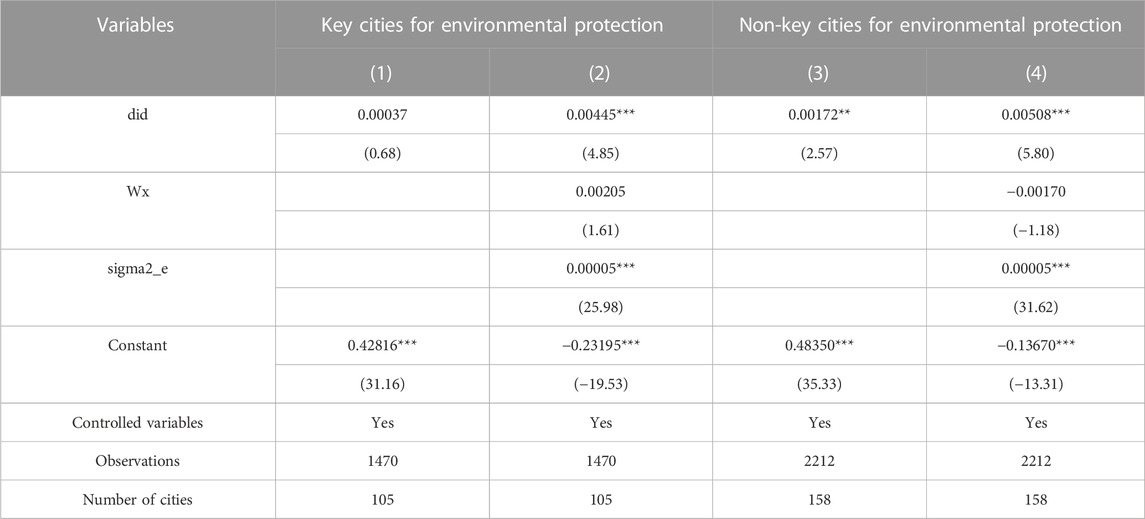- 1Hubei Institute of Economic and Social Development, Central China Normal University, Wuhan, China
- 2College of Agricultural Economics and Technology, Jiujiang Vocational University, Jiujiang, China
- 3School of Public Administration, Central China Normal University, Wuhan, China
Improvement of urban land green use efficiency (ULGUE) in the context of sustained economic growth is a major challenge for the regional sustainable development and ecological civilization construction in China. This study measures the ULGUE of 263 cities in China at the prefecture or above level, clarifies its spatio-temporal changes, investigates the effect of ecological civilization pilot demonstration area construction on ULGUE with the multi-period PSM-DID model and spatial Durbin difference model, and evaluates the spatial spillover effect of the policy. The results show that: 1) In terms of spatio-temporal changes, ULGUE shows a steady upward trend with time. From 2006 to 2019, the national mean value of ULGUE increases from 0.5284 to 0.6439, with an increase rate of 21.86%; in the spatial dimension, ULGUE is characterized by a pattern of eastern > national > central > western. 2) Ecological civilization pilot demonstration area construction has significantly improved the ULGUE of pilot cities by about 0.12% relative to that of non-pilot cities, which was validated by the robustness test. 3) Ecological civilization pilot demonstration area construction has significant positive spillover effects on the ULGUE of neighboring cities, which are related to the urban characteristics such as geographical location, resource endowment, and environmental protection intensity. 4) Ecological civilization pilot demonstration area construction has certain heterogeneity in its effect on ULGUE in different regions and cities, with a more significant promoting effect for non-eastern regions, non-resource-based cities, and non-key cities of environmental protection. Therefore, it is necessary to summarize the successful experience of ecological civilization pilot demonstration area construction and fully consider differential policies, so as to maximize the policy dividends while strengthening regional linkage, and further contribute to national popularization of this policy.
1 Introduction
Urban land use efficiency is an important factor affecting urban sustainable development and high-quality economic development. In the early stage, countries in the world tend to promote national economic growth while overlooking environmental pollution. Due to its unique land-based development model, China has become the fastest growing economy in the world over the past 30 years; however, as China’s economic development stage changes, the unsustainability of the traditional land use model has become increasingly apparent (Liu S Y et al., 2020). With the continuous acceleration of urbanization in most countries around the world, a series of problems such as environmental degradation and human-land conflicts have emerged gradually, with corresponding countermeasures successively introduced by each country (Pata., 2018). China’s built-up area grows to 62,400 km2 by 2021, with an increase of 36.99% compared with that 10 years ago1. China’s idle land in development zones alone reached 67,000 ha in 2020, with a continuous increase for two consecutive years2. The uncontrolled expansion of urban boundaries has resulted in inefficient urban land use and increasingly serious environmental pollution, leading to serious contradictions and conflicts between sustainable urban development and China’s ecological security (Tan et al., 2005; Wei et al., 2016). It is urgent to transform the traditional extensive urban land use to green and intensive urban land use. Therefore, China has put forward the important concept of “Lucid waters and lush mountains are invaluable assets”3, which is mainly aimed at transforming land use patterns, improving the living environment of both urban and rural residents, and strengthening the protection of resources and environment, and has expounded the great importance of green development. Accordingly, the focus of urban development in China has gradually shifted from blind pursuit of high-speed economic growth to seeking of a balance between economy and ecology, and environmental governance and ecological restoration have made certain progress. In this context, urban land green use efficiency (ULGUE), a new concept combining the two core elements of “green” and “efficiency”, emerges as the focus of regional sustainable development, whose importance has been widely recognized by the political and academic communities (Zhang Q et al., 2022). As an important standard to evaluate the green use of urban land, ULGUE is different from traditional land utilization efficiency. The core of ULGUE is to minimize urban land input factors and environmental costs as much as possible under certain production technology conditions to achieve the maximum economic output. Tan et al. (2021) combine the environmental pollution characteristics of urban land use activities and consider urban pollution index as “undesirable” output, achieving an efficient and green land use evaluation system. Therefore, this study mainly considers the coordination and unity of economic and environmental factors in the process of urban land use.
In 2013, China’s ecological civilization construction largely lagged behind the economic and social development as a whole. The laws, regulations, and their implementation could not meet the requirements of ecological civilization construction. Hence, China proposed to establish ecological civilization pilot demonstration area and plans by selecting regions with different developmental stages, resource endowments, and main functional requirements (provinces, cities, counties, towns, and villages), aiming to explore a typical and replicable mode of ecological civilization to be popularized nationwide, aiming to promote the economic indicators such as the total output value per unit area to the top in the country. Resource utilization indicators such as resource input-output ratio and resource consumption per unit output value have achieved significant breakthrough. Land resources such as forests and lakes have become low-carbon, green, and efficient in utilization, and the ecological environment has been restored. Fujian Province was appointed as the first ecological civilization pilot demonstration area in March 2014. In the following years, Fujian Province has achieved fruitful results in ecological construction: in 2020, its energy consumption per unit of GDP dropped by about 1.83% year on year4, and its energy conservation and consumption reduction were always one of the highest in the country; in 2021, its forest coverage rate reached 66.80% and had ranked the first in the China for many consecutive years5. Then, based on voluntary application, the National Development and Reform Commission announced the list of two batches of ecological civilization pilot demonstration areas in 2014 and 2015, and successively approved a total of 100 regions such as Miyun County, Beijing, Chengde City, Hebei Province, Qingpu District, Shanghai, and Jialing River Basin in Sichuan Province as ecological civilization pilot demonstration areas, which cover 47 prefecture-level cities6 (distribution of cities in the ecological civilization pilot demonstration area is shown in Figure 1).
Construction of ecological civilization pilot demonstration area is guided by ecological civilization and green development, aiming to significantly improve the level of urban greening by establishing a full-coverage indicator system. The system mainly includes the strictest protection and management for resources and environmental aspects such as land and resource allocation, green energy conservation and emission reduction, and ecological environment implemented to promote the construction of ecological civilization, so as to build a green development pattern with an appropriate balance between social or economic development and ecological civilization construction. According to the environmental Kuznets curve, the relationship between economic development level and environmental pollution degree displays an inverted “U” shape. In recent years, China has attached increasing importance to its own environmental problems, and the administrative units at different levels have been changing from mutual competition to cooperation, which has greatly advanced the arrival of “inflection point” of the inverted “U” curve. This not only helps China build strong confidence in dealing with environmental and development issues, but also plays an exemplary role in global environmental protection and green transformation and development, which is also of great significance to other developing countries. Obviously, whether from the perspective of practice or research value, the problems derived from interregional development in China are no longer limited to itself, but are becoming a major concern to the world. The starting point of this study is highly consistent with the above background, as it examines the policy effects presented by the ecological civilization pilot demonstration area construction, providing strong support for understanding the importance of public policies in green development. Therefore, exploring the impact of the construction of ecological civilization demonstration zones on the green utilization efficiency of urban land is a practical need to promote sustainable urban development and high-quality economic development. To this end, it is important to explore the effect of ecological civilization pilot demonstration policy on ULGUE in the pilot area and neighboring areas, and whether the effect has certain heterogeneity under different urban characteristics. This study seeks to answer these questions.
The possible marginal contributions of this study are as follows: 1) Theoretically, the connection channel between ecological civilization pilot demonstration policy and ULGUE is built at the municipal level. At the same time, by taking ULGUE as a breakthrough point, this study analyzes the policy effect of ecological civilization demonstration area construction, which is conducive to further enrichment of research on the theme of ULGUE and ecological civilization demonstration area construction. 2) Practically, the multi-period PSM-DID model and SDM-DID model are established in this study to solve the endogeneity problem in previous research, while the spatial Durbin difference model is adopted to deeply investigate the implementation effect of ecological civilization demonstration area construction with full consideration of spatial factors on policy effect, which not only helps to solve problems in the policy implementation process, but also provides a reference for the nationwide promotion of pilot policy.
2 Literature review
The literature related to this study can be mainly classified into two categories. The first category is related to ULGUE, and the research can be roughly divided into two stages. The first stage (2009–2019) is a concept formation stage, at which the concept of ULGUE is at its infant stage, but the prototype is already formed. Many researchers have noticed the relation between urban land use and green development, in view of the problem of pollution in the process of urban land use, and relevant studies have started to incorporate the pollutants of “three wastes” as an undesirable output into the measurement system of urban land use efficiency (Fukuyama and Weber, 2009; Verburg et al., 2010; Li et al., 2017; Zhao et al., 2018). The second stage (2019 to now) belongs to the concept development stage, at which ULGUE is explicitly introduced and conceptualized. The concept of ULGUE can be broadly divided into two schools of thoughts: one is defined based on the eco-socio-economic benefits of land use, and the other is defined through factor inputs and outputs (Wang and Pang, 2019; Liang et al., 2019). In terms of the influencing factors of ULGUE, previous research is usually focused on four aspects: economic factors (Hu and Qian, 2017), social factors (Nesru et al., 2021; Zhao et al., 2021; Zhao and Jiang, 2022), traffic location (Desalvo and Su, 2017), and policy factors (Macedo., 2008; Wang and Chi-Man, 2017). Besides, there have also been some studies concerning the internal relationship of industrialization (Ghosh and Chifos, 2017; Bird and Venables, 2020), urbanization (Hsing-Fu and Ko-Wan, 2015; Marco et al., 2015), regional integration (Cancello et al., 2020) with ULGUE. In the above studies, the econometric model was the mostly used tool to analyze issues related to ULGUE, mainly including the parametric method represented by stochastic Frontier production function model (Dong et al., 2020; Liu S C et al., 2020; Lu X et al., 2022), the non-parametric method represented by Data Envelopment Analysis (DEA) model (Fang et al., 2013; Lu et al., 2020; Chen et al., 2021; Liu et al., 2021; Ruan et al., 2022), SBM model and its improved model (Lin and Ling, 2021; Tang et al., 2021; Li et al., 2022). Compared with non-parametric methods such as DEA, which measure the land use efficiency through the linear programming model, the stochastic Frontier production function model can eliminate the impact of random factors through parameter estimation, and is more advantageous in evaluating land use efficiency (Gong and Sickles, 1989). Construction of an input-output indicator system is the framework for using the SFA model to analyze the efficiency of urban land use. In the existing research, most scholars select labor, capital, and land in the classic production function as the main input factor indicators, and economic output value as the output indicator. Moreover, the specific indicators need to fully reflect the characteristics of non-agricultural production activities (Wang et al., 2015; Jin et al., 2018; Liu S Y et al., 2020; Zhang et al., 2020). This provides important technical support for this study to measure the ULGUE.
Furthermore, ULGUE is a dynamic evolution process. Considering the significant differences in geographical location, resource endowment, and environmental protection importance among different cities in China, ULGUE will exhibit unstable characteristics under the influence of various factors, with heterogeneity in different cities and development stages (Wang et al., 2018; Guo et al., 2021; Lu X H et al., 2022). Some studies have revealed the spatial correlation and evolution characteristics of ULGUE in Chinese cities from various dimensions such as national, provincial, and urban agglomeration (Yang et al., 2015). The data in different studies are selected from different periods. Non-parametric kernel density estimation and statistical charts are mainly used to reflect the evolution characteristics and trend changes of ULGUE in a specific time period (Hu et al., 2018).
The second category of literature is focused on ecological civilization construction. Western scholars prefer to study the relationship between urban economic development and ecological environment protection (Dixon, 1997; Ms et al., 2022). Although they rarely mention the term “ecological civilization”, their study focus is highly similar to the concept of “ecological civilization” in essence. Research on ecological civilization in China began in 1982. In terms of indicator construction, with the issuance of the Measures for Evaluation and Assessment of the Objectives of Ecological Civilization Construction, the evaluation system of ecological civilization construction has been gradually developed to integrate economy, society, and environment, to explore and analyze the balance between ecological civilization construction and various social systems (Chen et al., 2020). In the research on ecological civilization construction, evaluation of the effect of pilot policies has always been hotspot of research. Among them, research on “ecological civilization pilot demonstration area” is mainly carried out on the provincial (Lv et al., 2022) or national scale (Zhang and Fu, 2023), and the synthetic control method (Chai et al., 2022; Wang K L et al., 2022) and difference-in-difference model (Hou et al., 2022; Zhang et al., 2023) are the mostly used methods. It has been found that the construction of ecological civilization pilot demonstration area can improve agricultural green efficiency (Lu and Xiong, 2020) and ecological total factor productivity (Pan et al., 2022), as well as inhibit carbon emissions (Zhang and Fu, 2023). Some studies are also focused on ecological civilization construction and new urbanization (Wang W X et al., 2022), resource recycling (Wang A et al., 2021), and industrial green transformation (Zhang W X et al., 2022). Some scholars have also explored the relationship between ecological civilization construction and urban land use. Some of them believe that in the context of ecological civilization construction, attention should be paid not only to the efficiency of urban land use, but also to the “undesired output” in the process of urban land use, and to the low-carbon, green and circular development of urban land use to prevent the ecological environment of land resources from being threatened (Liu J et al., 2022; Xiao et al., 2022; Zhang and Zhang, 2022). Sheng and Tan (2014) explored urban land carrying capacity evaluation method under the requirement of ecological civilization. The case analysis shows that it is practical to carry out the ecological civilization-related method. In summary, studies have been conducted to initially assess the policy of “ecological civilization pilot demonstration area”. However, the content of the studies is relatively homogeneous, and there is little literature that directly integrates both urban land use efficiency and ecological civilization pilot demonstration area construction into a unified framework. Moreover, it remains unclear whether the ecological civilization pilot demonstration area can improve urban land green use efficiency, which is exactly the concern of this study.
3 Mechanism analysis
In order to clarify the effect of establishing ecological civilization demonstration areas on ULGUE, this study tries to explore the inherent logic of ecological civilization demonstration area construction influencing ULGUE. The specific aspects are as follows:
Direct effect. In 2013, the Chinese government issued “National Ecological Civilization Pilot Demonstration Area Construction Plan (Trial)", clearly stating that the ecological civilization pilot demonstration area in China aims to spur up high-quality economic development, promote the saving and utilization of resource and energy, enhance ecological construction and environmental protection, and cultivate ecological culture and corresponding system and mechanism, which are the five major construction targets. All these targets are likely to influence ULGUE to some extent. Some scholars have pointed out the bidirectional coupling relationship between high-quality economic development and ULGUE. Social and economic development depends on utilization activities on urban construction land, and urban land use can help promote high-quality economic development (Yu et al., 2020; Zhou et al., 2020; Wu et al., 2021; Zhang and Dong, 2022). The saving and utilization of resource and energy as well as ecological construction and environmental protection include land development intensity, unit construction land production value, and industrial waste utilization rate into the indicator system. The system and mechanism construction further incorporates resource depletion, environmental damage, and ecological benefits into the indicator system. Therefore, based on the ecological civilization demonstration area policy itself, its construction goals exert a possible direct effect on ULGUE.
Indirect effect. The ecological civilization pilot demonstration area policy is essentially a pilot policy with comprehensive application of environmental regulation means, such as mandatory policies and targeted regulations, which are used by the government to reduce the negative externality of environmental pollution in production and life. According to the Porter hypothesis, on the one hand, environmental regulation advances technological innovation of enterprises through the “reversed transmission of pressure effect” caused by cost reduction. In the long term, the technical innovation will compensate for the costs brought by environmental regulation and thereby the comprehensive land output per unit area shows a significant upward trend (Linde, 1995). On the other hand, under limitations from the certain environmental protection policy framework, the “survival of the fittest” competition law brought about by environmental regulations facilitates the elimination of outdated production capacity. The long-term “competition effect” will promote the optimization and adjustment of industrial structure, thereby improving the output quality of urban use and reduce unexpected output, which contributes to elevation of ULGUE.
4 Research design
4.1 Stochastic frontier production function model
Traditional microeconomics assumes that production entities are all economically rational with the ability to achieve production optimization, and uncontrollable random factors are the only factors that may cause deviation from the state of optimum production. However, in reality, production entities will deviate from the optimum production state due to various factors, resulting in very low efficiencies. In stochastic Frontier theory, the goal of production entities to pursue optimum production is still valid, but in reality some other factors besides the uncontrollable random factors can also cause deviation from the optimum production state. Therefore, a concept of “production Frontier” emerges, which refers to the boundary of minimum input and maximum output for production entities under certain technical conditions. In the process of urban development, it is difficult for land use to achieve the optimal output with minimum input. Therefore, the stochastic Frontier theory can be used to analyze land use efficiency. It is believed that under certain technical conditions, the urban land use efficiency will be higher when the actual output of urban land use gets closer to the production Frontier, and vice versa. This study establishes the stochastic Frontier production function model in the Cobb-Douglas function form. The specific model is as follows:
In the formula,
This study adopts the non-agricultural GDP per unit area and industrial wastes (waste water, waste gas, and solid waste) to represent the desirable output and undesirable output of urban land use, respectively. In addition, by referring to, the model is treated by logarithmic transformation:
In Formula 2,
ULGUE can be expressed as the ratio of mean actual output to the mean under fully effective technical conditions. The specific formula is as follows:
where
Based on the connotation of ULGUE and existing research results (Lu et al., 2020; Liu J L et al., 2022), this study constructs the following indicator system to measure ULGUE (more details in Table 1). In order to meet the single output for SFA model, this study uses the entropy weight method to construct a comprehensive index of desirable output and non-desirable output to calculate the pure output value.
4.2 Multi-period PSM-DID model
By taking the ecological civilization pilot demonstration area construction as a quasi-natural experiment, this study divides the sample cities into two groups according to whether they are ecological civilization pilot demonstration areas and then compares them to evaluate the effect of the pilot policy on ULGUE. The difference-in-difference model is usually applied to evaluate the policy effect. Since the ecological civilization pilot demonstration area construction is gradually carried out in different batches, we adopt the multi-period DID model at different time points. Moreover, in order to eliminate the selectivity bias on sample processing, the propensity score matching method is used. To sum up, this study uses multi-period PSM-DID for regression analysis, and the specific model is as follows:
In the formula,
4.3 SDM-DID model
In the traditional difference model, it is necessary to satisfy the hypothesis of stable direction for individual treatment effects, which means that policy intervention will not produce spillover effect due to ignorance of the spatial spillover effect of the policy. In contrast, spatial factors are added in the SDID model, and the model effectively makes up the lack of observation on the control group in the implementation of the pilot policy by investigating the spatial spillover effect. By referring to existing results (Mi et al., 2017; Jia et al., 2021), this study further adds the spatial lag term of the dependent variable on the basis of SDID model, and obtains the spatial Durbin-difference model to investigate the spatial effect of ecological civilization pilot demonstration area policy on ULGUE. The specific construction model is as follows:
In the formula,
4.4 Variable selection and data description
4.4.1 Variable selection
(1) Dependent variable:
(2) Independent variable: the dummy variable of pilot policy of the ecological civilization pilot demonstration area, which is
(3) Control variable: By considering that other urban characteristic factors may affect the ULGUE, this study selects six variables as control variables (Table 2 for details) A) Real estate investment level (re). Inspired by the policy, the local government tends to introduce financial expenditure to real estate industry with high returns. Hence, the impact of real estate investment level on ULGUE cannot be ignored, which is represented by the completed amount of real estate development investment (Su and Yang, 2022) B) informatization level (il). Informatization is the basic condition for urban economic development. Urban information level is expressed by the ratio of the number of employees in information transmission, computer service, and software industry to that at the end of year (Song et al., 2020) C) Industrial structure (is). The industrial structure determines urban land use structure, since different industries are of different land use modes. For example, the tertiary industry is usually characterized by a high plot ratio and great land use efficiency. This study selects the added value of the tertiary industry to represent industrial structure (Peng et al., 2017) D) Infrastructure investment (ii). Investment in urban infrastructure can attract the flow of factors. For most cities, more complete urban infrastructure represents higher ULGUE. Infrastructure investment is represented by per capita road area (Ge et al., 2021) E) Ecological environment (ee). After the material satisfaction, people tend to pursue more beautiful and livable residences. This study reflects the level of urban greening based on the per capita green space area, and the impact of ecological environment greening on the ULGUE (Li et al., 2022) F) Financial development level (fdl). Financial support has certain impacts on the mode, structure, and efficiency of urban land use. This study selects the per capita loan balance of financial institutions at the end of year to represent the financial development level (Wang X M et al., 2021).
4.4.2 Data description
In view of different effects of the policy at different administrative levels such as provinces, cities, districts and towns as well as data availability, this study excludes provinces, districts, and towns in the list of ecological civilization pilot demonstration area and cities that were withdrawn or with serious missing of data during the study period. Finally, 263 cities at prefecture level and above are retained as samples (excluding data of Tibet, Hong Kong, Macao and Taiwan), as the prefecture level and above cities accounts for 90.38% of the total number of cities in China, which has good representativeness. A total of 47cities at the prefecture level included in the list published by the National Development and Reform Commission in 2014 and 2015 are assigned to the experimental group and the remaining 216 cities are classified into the control group. The research period is 2006–2019.
The data in this study were all derived from China City Statistical Yearbook, China Urban Construction Statistical Yearbook, and statistical yearbooks of provinces and cities. A few missing data were supplemented by linear interpolation. Furthermore, in order to reduce heteroscedasticity and avoid the influence of outliers on research results, this study takes logarithms for all numerical variables. Table 3 shows the descriptive statistical results of each variable.
5 Empirical analysis
5.1 ULGUE measurement
Based on the input-output panel data for 263 cities in China from 2006 to 2019, the random Frontier analysis is conducted through Frontier4.1 software. The measured ULGUE results are shown in Table 4.
From the test results, LR test of the one-sided error has passed the test, with a gamma value is 0.772, indicating that the technical inefficiency accounts a lot of the error. The parameter coefficients have all passed the t-test, and the parameter estimation is accurate at 99% confidence level. Therefore, it is applicable and scientific to use the SFA model to calculate ULGUE in this paper. From the elasticity of input-output,
Figure 2 is a line chart for the mean values of ULGUE in different regions from 2006 to 2019. Due to the imbalanced development in China, cities in different locations may have significant differences, which is likely to lead to differences in ULGUE. Therefore, by referring to “Seventh Five Year Plan”, the 263 cities in China are divided into eastern, central and western regions7. The results show that the overall ULGUE level has been steadily increasing, while the mean value of national ULGUE is about 0.58, indicating that there is still 42% of improvement room for national ULGUE in theory.
From the perspective of time, ULGUE shows a steadily rising trend. In general, the mean value of ULGUE for 263 cities in China in 2006, 2014, 2015, and 2019 is 0.5284, 0.6018, 0.6105, and 0.6439, respectively, with an increasing rate of 21.86% during the study period. From the regional perspective, the ULGUE value shows significant differences in different regions, which follows a general pattern of eastern > national > central > western.
According to statistics, the ULGUE had been improved from 2006 to 2019 (Table 5 below), but the degree of improvement shows some differential results, with the main transformation occurs from Class II to Class I, from Class III and Class IV to Class II, and from Class V to Class III. Among them, 100% of Class II cities (38 cities) have been transformed into Class I cities; 76.32% of Class III (58 cities) and 100% of Class IV cities (85 cities) have been transformed into Class II cities; and 90.91% of Class V cities (40 cities) have been transformed into Class III cities. According to the mean value of ULGUE of each city in 2006, cities at middle and low levels (Class III and below) account for 77.95%, including 205 individual cities; in 2019, cities at the middle and low levels (Class III and below) account for 15.21%, including 40 individual cities. These results demonstrate that ULGUE in China has been significantly improved year by year during the study period.
5.2 Benchmark regression
The estimated results for the effects of ecological civilization pilot demonstration area policy on ULGUE are shown in Table 6. The dependent variable is ULGUE, and the independent variable is the policy dummy variable did of ecological civilization pilot demonstration area, which is regressed by using stata16. Model 1) and model 2) are basic regression results obtained by the DID model before and after adding control variables, based on unmatched data. Model 3) and model 4) are regression results obtained by using the PSM-DID model without and with control variables, respectively. The regression results reveal that the independent variable did is significant in the 95% confidence interval, indicating that the ecological civilization pilot demonstration area policy has a significant improving effect on ULGUE, and ULGUE in pilot cities is about 0.12% higher than that in non-pilot cities.
Among the control variables, the real estate investment level (re) has a significant negative impact on ULGUE, while the informatization level (il), industrial structure (is), infrastructure investment (ii), ecological environment (ee) and financial development level (fl) have significant positive impacts. The possible reasons are as follows. In terms of the real estate investment level, the land fiscal expenditure of local government tends to flow to infrastructure and public services to enhance urban competitive advantage, and alleviate the boundary expansion of population pressure in the downtown. This preferential behavior will increase investment in the real estate and construction industries, and then induce overcapacity caused by excessive competition in upstream raw material industries, which will have certain inhibitory effects on ULGUE (Yu and Su, 2022). Improvement of informatization level can result in Jacobs technological externalities in the behavior of urban enterprises, and improve the ULGUE by enhancing economic output (Zhang and Dong, 2022). The added value of the tertiary industry, which is used to represent the industrial structure, shows a positive coefficient, possibly because the increasing added value of the tertiary industry can facilitate the steady growth of economic output per unit area and alleviate the pressure of environmental pollution caused by waste emissions, thereby improving the ULGUE. Urban infrastructure investment can attract and accelerate the flow of factors, which can stimulate the effective agglomeration of population and industries. The ecological environment can represent people’s living environment and ecological benefits. Improvement of urban greenery level can improve the ULGUE by affecting the environmental output. A higher financial development level indicates that the capital is more likely to flow to high-benefit projects in a more competitive market, leading to a higher land development intensity, which can enhance the land use output and promote ULGUE.
5.3 Parallel trend test
Parallel trend test is the premise for using the difference-in-difference model to evaluate the policy effect. Based on previous research results (Beck et al., 2010), this study adopts the event study method to conduct the parallel trend test. Stata16 is used to draw the parallel trend test chart for more intuitive display of the results as shown in Figure 3, where the vertical axis represents estimated values of regression coefficients and the horizontal axis indicates the years before and after the implementation of ecological civilization pilot demonstration area policy.
As shown in Figure 3, regression coefficients are not significant before the implementation of ecological civilization pilot demonstration area policy, indicating that there is no significant difference in ULGUE before the implementation of the policy. After implementation of the policy, regression coefficients become significantly positive for three consecutive years, implying that implementation of ecological civilization pilot demonstration area policy has a significant impact on ULGUE. Therefore, it can be proved that the study passes the parallel trend test hypothesis.
5.4 Robustness test
Since an independent declaration of local government is necessary for the ecological civilization pilot demonstration area, there is a phenomenon of remarkable ecological civilization conditions in the declaration area, causing the endogeneity in this study. Therefore, a robustness test is conducted as follows. In this study, tail shrinkage treatment, lag treatment, placebo test and excluding the influence of other policies are used to test the robustness of research conclusions. For the tail shrinkage treatment, to avoid the interference of abnormal values or extreme values on the test results, core variables such as ULGUE are treated with regression after tail shrinkage of data, and the results are shown in Table 7. Model 1) is 1% tail shrinkage; model 2) is 5% tail shrinkage; and model 3) is 10% tail shrinkage. The results show that the regression coefficient is significant in the 99% confidence interval whether the samples are treated with 1%, 5% or 10% tail shrinkage, suggesting that the ecological civilization pilot demonstration area policy always has a significantly positive effect. For the lag treatment, in view of the hysteresis for the effect of ecological civilization pilot demonstration area policy, this study carries out lag treatment on the core independent variable “pilot cities”, and the results are shown in columns 4) and 5) of Table 7. Among them, model 4) and model 5) display the regression results of one-period and two-period lag treatment, respectively, both of which show significantly positive coefficients. For the placebo test, experimental groups are randomly selected. To verify that the increase in ULGUE in the experimental group was indeed caused by the ecological civilization pilot demonstration area construction, rather than being influenced by other non-observational factors, this study conducted a placebo test by randomly assigning ecological civilization demonstration zones and conducting 500 random sampling to obtain 500 estimation coefficients. Figure 4 shows the probability density distribution of the estimation coefficient, and the vertical solid line is the estimated value of the benchmark regression coefficient. It can be seen that the coefficient estimates obtained from the placebo test are concentrated around the 0 value, indicating that the random sampling sample combination has no effect on ULGUE. Therefore, it can be considered that the significant promoting effect of the ecological civilization demonstration area on ULGUE is real, and the results in the benchmark regression are robust. For excluding the influence of other policies. During the long research period, ULGUE may be influenced by other similar policies. This study selects two types of policies, namely, “civilized city” and “low-carbon city”, which are similar to the “ecological civilization pilot demonstration area” policy, to be included in the regression. The results are shown in Model 6) of Table 7. The results indicate that after adding other policies, the estimated coefficients remain significantly positive, with the coefficient sign unchanged and the value slightly increased, revealing that adding other policies will not affect research conclusions. These robustness test results further consolidate the reliability of basic regression results, indicating the reliability of the research conclusion that construction of ecological civilization pilot demonstration area can improve the ULGUE.
5.5 Spatial spillover effect
During the construction of an ecological civilization pilot demonstration area, neighboring cities may learn from, cooperate, and exchange with the pilot cities, which will boost the improvement of ULGUE in surrounding cities. Moreover, low-end industries unfavorable for regional development or with high pollution may be mitigated from pilot cities to neighboring cities, which will indirectly hinder the improvement of ULGUE in the neighboring areas. Hence, the next section will analyze the spatial spillover effect of ecological civilization pilot demonstration area policy.
First, a spatial autocorrelation test is performed on the dependent variable. This study conducts the global Moran test on ULGUE. A positive and negative value of Moran’s I indicate the existence of positive and negative spatial correlations, respectively. Table 8 shows that in the adjacency matrix and inverse distance matrix, the Moran’s I value of ULGUE is greater than 0 and increases year by year during the study period, which passes the significance test. These results indicate that the ULGUE in China has a positive correlation in space, and the clustering feature of positive correlation is increasing gradually.
Secondly, the ULGUE data in 2006 and 2019 are treated with local Moran test and a local Moran scatter diagram is plotted. The results are shown in Figure 5 (points represent cities). The first quadrant represents the “high-high” aggregation area; the second quadrant stands for the “low-high” aggregation area; the third quadrant represents the “low-low” aggregation area; and the fourth quadrant indicates the “high-low” aggregation area. As a result, most of ULGUE for Chinese cities is concentrated in the first and third quadrants, suggesting that cities in “high-high” and “low-low” aggregation areas are dominant. These results indicate that ULGUE of each city has an obvious spatial positive effect, which is consistent with the test results of global Moran’s I.
Based on the above conclusions, the spatial Durbin model (SDM) is used to further estimate the effect of ecological civilization pilot demonstration area construction on ULGUE. According to the LR test and Hausman test, the results pass the significance test and reject the original hypothesis, indicating that the SDM will not degenerate into the spatial error model (SEM) and the spatial lag model (SLR) and support the fixed effect. Therefore, it is more appropriate to choose SDM with both time and individual fixed effects for analysis.
Table 9 summarizes the benchmark regression results of spatial Durbin and decomposition results of the spatial spillover effect. Among them, model 1) shows the benchmark regression results of SDM, and models (2–4) show the empirical results after decomposition of the spatial spillover effect generated by the ecological civilization pilot demonstration area policy determined with the partial differential method.
Based on the benchmark regression results of spatial Durbin, the core independent variable did is positive and significant at the level of 1%, suggesting that the implementation of ecological civilization pilot demonstration area policy contributes to the improvement of ULGUE. The spatial spillover effect is significantly positive, indicating that the implementation of this policy can improve the ULGUE of adjacent areas around pilot cities.
The direct effect in model 2) represents the local effect, which refers to the effect of ULGUE within pilot cities. The indirect effect in model 3) is the spillover effect of ecological civilization demonstration area construction in surrounding areas on the ULGUE of local areas (non-pilot cities). The total effect in model 4) represents the comprehensive impact. According to the decomposition results of spillover effect in further analysis, the direct effect, indirect effect, and total effect of ecological civilization pilot demonstration area construction are all positive and significant at the level of 1%, which is consistent with the above analysis.
These results indicate that the implementation of ecological civilization pilot policy can promote the ULGUE of the pilot cities and also have positive spillover effects on the neighboring cities. The possible reason is that the construction of pilot cities promotes the cross-regional flow of talents, capital, technologies and other factors through the scale effect and agglomeration effect, which has a spatial radiation effect on neighboring cities and then inspires surrounding cities to imitate the pilot cities, thereby indirectly achieving the upgradation of ULGUE of neighboring cities in the ecological civilization pilot demonstration area.
5.6 Further heterogeneity analysis
5.6.1 Urban geographical location
Up to now, the development differences between regions in China cannot be ignored, which may have great impacts on the implementation effect of pilot policy. To explore differences in the effect of ecological civilization pilot demonstration area policy on ULGUE of cities in different geographical locations, this study divides the sample cities into eastern and non-eastern cities according to their location for regression analysis, and the regression results are shown in Table 10.
Model 1) and model 3) show that the ecological civilization pilot demonstration area policy has a significant positive effect on ULGUE in non-eastern regions, but the effect is insignificant in eastern regions, indicating that ecological civilization construction can better promote the ULGUE in non-eastern regions. Model 2) and model 4) demonstrate that the ecological civilization pilot demonstration area policy has significant positive spatial spillover effects on ULGUE in both eastern and non-eastern regions, and the spatial spillover effect in non-eastern region is more significant than that in eastern region.
To sum up, the reason may be that ecological civilization construction in the non-eastern region is still at an early stage with a more significant marginal role. In contrast, developed economy and fierce competition among cities together with relatively fierce competition for professional talents and high-tech enterprises in the eastern region may have restrained the full release of policy dividend. This effect not only causes the insignificant policy effect on ULGUE for cities, but also results in a weaker spillover effect in the eastern region.
5.6.2 Urban resource endowment
Natural resource endowment is different between regions, which may lead to effect heterogeneity of ecological civilization pilot demonstration area policy on ULGUE. Hence, this study classifies sample cities into resource-based and non-resource-based cities for regression analysis according to the National Resource-based City Sustainable Development Plan issued by the State Council in 2013. The regression results are shown in Table 11.
As shown in model 1) and model 3), ecological civilization pilot demonstration area construction has a significant positive effect on ULGUE in non-resource-based cities, while has no significant effect on ULGUE in resource-based cities. This result indicates that for non-resource-based cities, ecological civilization construction can promote ULGUE, probably because the leading industry in resource-based cities is featured by resource exploitation and processing, where environmental pollution and resource waste are relatively serious, resulting in less effective policy dividend in resource-based cities.
Model 2) and model 4) show that in both resource-based and non-resource-based cities, implementation of ecological civilization pilot demonstration area policy has a significant positive spatial spillover effect on ULGUE in surrounding regions of pilot cities, particularly for non-resource-based cities. The reason may be that non-resource-based cities have lower environmental pollution, less pressure of economic transformation, and more focus on comprehensive benefits, which will be learnt and imitated by neighboring cities, thereby improving the spatial spillover effect.
5.6.3 Environmental protection policy intensity
Environmental protection policies may have certain synergistic effect with ecological civilization pilot demonstration area construction to improve ULGUE. Therefore, this study examines the heterogeneity of the effect of urban ecological civilization pilot demonstration area construction on cities with different environmental protection policy intensities. According to the 113“key cities for environmental protection8” designated in the “11th Five-Year Plan” for environmental protection issued by the State Council in 2007, the sample cities are divided into key and non-key cities of environmental protection for regression analysis. The regression results are shown in Table 12.
Model 1) and model 3) show that ecological civilization pilot demonstration area construction has a significant positive effect on ULGUE in non-key cities of environmental protection, but makes no significant difference in ULGUE in key cities. According to model 2) and model 4), implementation of ecological civilization pilot demonstration area policy has no significant spatial spillover effect in both key and non-key cities.
In summary, for key cities of environmental protection, the ecological civilization pilot demonstration area policy fails to promote the ULGUE of both local and neighboring cities. This result indicates that implementation of this policy has no remarkable contribution to ULGUE when the spatial spillover effect is considered, but may have potential growth effect in both local and adjacent areas. More effectively targeted policies will generate a positive influence on ULGUE in key cities of environmental protection. For those non-key cities of environmental protection, the pollution industry makes little contribution to urban economic growth, and there is relatively lower resistance for the improvement of ULGUE through policy regulation. Implementation of ecological civilization pilot demonstration area policy can better improve ULGUE, and its insignificant spatial spillover effect on neighboring cities may be related to the “siphon effect".
6 Conclusion and discussion
6.1 Conclusion
From the perspective of promoting regional sustainable development, breaking the bottleneck constraints of resources and environment and balancing the relationship between economic development and ecological civilization construction will be one of the important challenges faced by China’s sustainable development policies in the future. Evaluating the role of the “Ecological Civilization Pilot Demonstration Area” policy in improving the efficiency of urban land green utilization is of great significance for improving this policy and correctly handling the relationship between economic development and ecological civilization construction. Therefore, this study measures the ULGUE of 263 cities at the prefecture and above level in China from 2006 to 2019, and uses the multi-period PSM-DID model and SDM-DID spatial econometric model to empirically test the effect of ecological civilization pilot demonstration area policy on ULGUE. The main conclusions are as follows.
(1) The ecological civilization pilot demonstration area policy can significantly increase the ULGUE, as the ULGUE of pilot cities is about 0.12% higher than that of non-pilot cities. From the perspective of time, the ULGUE in China shows a steady upward trend. However, the overall ULGUE level is relatively low in China with obvious regional differences, and there is still 48% of space for improvement. From the perspective of space, the ULGUE presents a spatial pattern of eastern > national > central > western.
(2) The ecological civilization demonstration area policy has obvious spatial heterogeneity in its improving effect on ULGUE. From the perspective of geographical location, the policy has no significant promoting effect on ULGUE in the eastern region, but remarkably improves ULGUE in the non-eastern region. From the perspective of resource endowment, the policy has no significant effect on ULGUE in resource-based cities, but can significantly promote ULGUE in non-resource-based cities. From the perspective of environmental protection policy intensity, the policy can promote ULGUE in non-key cities of environmental protection, but shows no significant effect on ULGUE in key cities.
(3) Implementation of ecological civilization pilot demonstration area policy can not only promote the ULGUE of the pilot cities, but also help to improve the ULGUE in surrounding cities through the spatial spillover effect, which is related to urban characteristics such as urban geographical location, resource endowment, and environmental protection intensity. The non-eastern region and non-resource-based cities generally have stronger spatial spillover effects; key environmental protection cities have potential growth effect; while non-key environmental protection cities have no significant spatial spillover effect.
6.2 Policy recommendations
Based on the above findings, the policy recommendations of this study are as follows.
(1) More attention should be paid to the improving effect of ecological civilization demonstration area policy on ULGUE. Besides, the scope of pilot cities should be gradually expanded while summarizing and popularizing the pilot policy experiences. Cities that have not conducted ecological civilization pilot construction should fully mobilize their regional resources to learn from the successful cases in combination with their own urban characteristics. Moreover, the government should coordinate national strategic planning and deployment, so as to gradually expand the pilot scope of ecological civilization demonstration area and effectively achieve part-to-whole development.
(2) In the implementation of ecological civilization pilot demonstration area policy, full consideration should be given to the geographical location, resource endowment, environmental protection intensity, and other urban characteristics that may affect the policy implementation effect. In response to ecological civilization pilot policy, the local government should grasp the time node and refine the implementation plan of pilot policy in combination with actual urban situation. On the one hand, it is not rational to blindly copy the experience of surrounding cities or other pilot cities. On the other hand, the pilot policy has a more significant promoting effect on ULGUE in non-eastern regions, non-resource-based cities and non-key cities of environmental protection. Therefore, it is necessary to accelerate ecological civilization construction in such cities, so as to maximize the policy effectiveness and improve the ULGUE of these cities and even the whole region.
(3) In view of the spillover effect, the central and western regions and non-resource-based cities are supposed to strengthen infrastructure construction in relevant economic fields, so as to expand the scope of ecological civilization pilot cities and give full play to spillover dividends. The eastern region and resource-based cities should promote the integration and development of ecological civilization and social and economic industries. Moreover, it is necessary to strengthen industrial cooperation between regions and strictly prevent the transfer of pollution industries to neighboring regions. By establishing a cross-regional ecological compensation mechanism and industrial transfer guidelines, the industrial transfer should be carried out in a green way to promote the green and sustainable development of Chinese cities.
6.3 Limitations and future prospects
This study may have the following limitations.
1) Due to the lack of accurate and complete environmental data such as greenhouse gas emissions and soil erosion, this study only uses industrial wastes to measure the unexpected output for ULGUE, there is still space for improvement. In addition, the time limit for measuring the ULGUE in this study is 2019, which means that the follow-up study needs to select data with higher accuracies and updated years to measure national ULGUE. 2) By taking into account the difference in policy effect on administrative areas, this study only uses Chinese cities as the research object when empirically testing the ecological civilization pilot demonstration area policy. The effects of pilot policy at province, district, county and other levels also present in the ecological civilization pilot demonstration area are eliminated. Since we use municipal panel data, the regression coefficient between the two is relatively small when capturing the impact of ecological civilization pilot demonstration area construction on urban land green use efficiency, which is not only related to the setting of the explained variable ULGUE, but also limited by the availability of data. Therefore, when only considering prefecture level cities, the construction of ecological civilization demonstration zones is indeed limited in improving the overall ULGUE. Further research should pay more attention to this aspect, and further test the comprehensiveness of samples and the policy effect at different administrative levels. 3) This study is an exploratory study of the policy effect of ecological civilization pilot demonstration area construction on ULGUE. We have only qualitatively analyzed the impact mechanism of the construction of ecological civilization demonstration zones on the green utilization efficiency of urban land theoretically, and have not yet conducted quantitative analysis on it. Future research can be conducted to reveal the specific mechanism for ecological civilization pilot demonstration area policy to improve ULGUE.
Author contributions
Conceptualization, methodology, formal analysis, writing-original draft preparation and visualization, QW; Validation, DW; Writing-editing, SL. All authors contributed to the article and approved the submitted version.
Funding
This research was funded by the National Natural Science Foundation of China (42171286 and 71974071).
Conflict of interest
The authors declare that the research was conducted in the absence of any commercial or financial relationships that could be construed as a potential conflict of interest.
Publisher’s note
All claims expressed in this article are solely those of the authors and do not necessarily represent those of their affiliated organizations, or those of the publisher, the editors and the reviewers. Any product that may be evaluated in this article, or claim that may be made by its manufacturer, is not guaranteed or endorsed by the publisher.
Footnotes
1The data is from the Ministry of Housing and Urban-Rural Development of China. https://www.ceicdata.com/zh-hans/china/urban-area/area-of-built-district
2The data is from the “Notice on the Monitoring and Statistics of Land Intensive Use in National Development Zones in 2020” issued by the People’s Government of the People’s Republic of China. http://www.gov.cn/xinwen/2021-01/13/content_5579414.htm
3Quoted in 《Readings from General Secretary Xi Jinping’s Series of Important Speeches》, Study Press and People’s Publishing House, 2016, p. 230
4The data is from Fujian Provincial Statistical Yearbook
5The data is from China Statistical Yearbook
6The list is based on the relevant policy information published on the official website of the National Development and Reform Commission. The 47 prefecture level cities are Chengde, Zhangjiakou, Ordos, Bayannur, Siping, Yichun, Zhenjiang, Hangzhou, Lishui, Mount Huangshan, Linyi, Zibo, Zhengzhou, Nanyang, Shiyan, Yichang, Meizhou, Shaoguan, Yulin, Chengdu, Ya’an, Yan’an, Dingxi Qinhuangdao, Baotou, Wuhai, Dalian, Jilin, Baicheng, Mudanjiang, Qiqihar, Nanjing, Nantong, Ningbo, Xuancheng, Bengbu, Jinan, Xuchang, Puyang, Huangshi, Jingzhou, Hengyang, Dongguan, Guilin, Lanzhou, Jiuquan and Shizuishan
7The eastern region includes 109 cities: Anshan, Baise, Baoding, Beihai, Beijing, Benxi, Binzhou, Cangzhou, Changzhou, Chaozhou, Chengde, Chongzuo, Dalian, Dandong, Dezhou, Dongguan, Dongying, Fangchenggang, Foshan, Fuzhou, Fushun, Fuxin, Guangzhou, Guigang, Guilin, Haikou, Handan, Hangzhou, Hechi, Heyuan, Hengshui, Huludao, Huai’an, Jinan, Jining, Jiaxing, Jiangmen, Jieyang, Jinhua, Jinzhou, Guests Langfang, Lishui, Lianyungang, Liaoyang, Liaocheng, Linyi, Liuzhou, Longyan, Maoming, Meizhou, Nanjing, Nanning, Nanping, Nantong, Ningbo, Ningde, Panjin, Putian, Qinzhou, Qinhuangdao, Qingdao, Qingyuan, Quzhou, Quanzhou, Rizhao, Sanming, Sanya, Xiamen, Shantou, Shanwei, Shanghai, Shaoguan, Shaoxing, Shenzhen, Shenyang, Shijiazhuang, Suzhou, Suqian, Taizhou, Tai’an, Taizhou, Tangshan, Tianjin Tieling, Weihai, Weifang, Wenzhou, Wuxi, Wuzhou, Xingtai, Xuzhou, Yantai, Yancheng, Yangzhou, Yangjiang, Yingkou, Yulin, Yunfu, Zaozhuang, Zhanjiang, Zhangjiakou, Zhangzhou, Zhaoqing, Zhenjiang, Zhongshan, Zhoushan, Zhuhai, Zibo; The central region includes 105 cities: Anqing, Anyang, Bayannur, Baicheng, Baishan, Bengbu, Baotou, Chenzhou, Chizhou, Chifeng, Chuzhou, Daqing, Datong, Ordos, Ezhou, Fuzhou, Fuyang, Ganzhou, Harbin, Hefei, Hebi, Hegang, Heihe, Hengyang, Hohhot, Hulunbeier, Huaihua, Huaibei, Huainan, Huanggang, Mount Huangshan, Huangshi, Jixi, Ji’an, Jiamusi, Jiaozuo, Jincheng, Jinzhong Jingmen, Jingzhou, Jingdezhen, Jiujiang, Kaifeng, Liaoyuan, Lu’an, Loudi, Luoyang, Luohe, Lvliang, Ma’anshan, Mudanjiang, Nanchang, Nanyang, Pingdingshan, Pingxiang, Puyang, Qitaihe, Qiqihar, Sanmenxia, Shangqiu, Shangrao, Shaoyang, Shiyan, Shuangyashan, Shuozhou, Siping, Songyuan, Suzhou, Suihua, Suizhou, Taiyuan, Tonghua, Tongliao, Tongling, Wuhai, Ulanqab, Wuhu, Wuhan, Xianning Xiangtan, Xiangyang, Xiaogan, Xinzhou, Xinxiang, Xinyu, Xinyang, Xuchang, Xuancheng, Yangquan, Yichun, Yichang, Yichun, Yiyang, Yingtan, Yongzhou, Yueyang, Yuncheng, Zhangjiajie, Changchun, Changsha, Changzhi, Zhengzhou, Zhoukou, Zhuzhou, Zhumadian; The western region includes 49 cities: Ankang, Anshun, Bazhong, Baiyin, Baoji, Baoshan, Chengdu, Dazhou, Deyang, Guang’an, Guangyuan, Guiyang, Hanzhong, Jiuquan, Kunming, Lanzhou, Leshan, Liupanshui, Luzhou, Meishan, Mianyang, Nanchong, Neijiang, Panzhihua, Qingyang, Qujing, Shangluo, Shizuishan, Suining, Tianshui, Tongchuan, Weinan, Wuzhong, Wuwei, Xi’an, Xining, Xianyang, Ya’an, Yan’an, Yibin Yinchuan, Yulin, Yuxi, Zhangye, Zhaotong, Chongqing, Ziyang, Zigong, Zunyi
8List of key cities for environmental protection: Beijing, Tianjin, Shanghai, Chongqing, Shijiazhuang, Taiyuan, Hohhot, Shenyang, Changchun, Harbin, Nanjing, Hangzhou, Hefei, Fuzhou, Nanchang, Jinan, Zhengzhou, Wuhan, Changsha, Guangzhou, Nanning, Haikou, Chengdu, Guiyang, Kunming, Lhasa, Xi’an, Lanzhou, Xining, Yinchuan, Urumqi, Dalian, Qingdao, Ningbo, Xiamen, Shenzhen, Qinhuangdao, Tangshan Baoding, Handan, Changzhi, Linfen, Yangquan, Datong, Baotou, Chifeng, Anshan, Fushun, Benxi, Jinzhou, Jilin, Mudanjiang, Qiqihar, Daqing, Suzhou, Nantong, Lianyungang, Wuxi, Changzhou, Yangzhou, Xuzhou, Wenzhou, Jiaxing, Shaoxing, Taizhou, Huzhou, Maanshan, Wuhu, Quanzhou, Jiujiang, Yantai, Zibo, Tai’an, Weihai, Zaozhuang, Jining, Weifang, Rizhao, Luoyang, Anyang, Jiaozuo Kaifeng, Pingdingshan, Jingzhou, Yichang, Yueyang, Xiangtan, Zhangjiajie, Zhuzhou, Changde, Zhanjiang, Zhuhai, Shantou, Foshan, Zhongshan, Shaoguan, Guilin, Beihai, Sanya, Liuzhou, Mianyang, Panzhihua, Luzhou, Yibin, Zunyi, Qujing, Xianyang, Yan’an, Baoji, Tongchuan, Jinchang, Shizuishan, Karamay, 113 cities in total
References
Beck, T., Levine, R., and Levkov, A. (2010). Big bad banks? The winners and losers from bank deregulation in the United States. J. finance 65, 1637–1667. doi:10.1111/j.1540-6261.2010.01589.x
Bird, J., and Venables, A. J. (2020). Land tenure and land-use in a developing city: A quantitative spatial model applied to kampala, Uganda. J. Urban Econ. 119, 103268. doi:10.1016/j.jue.2020.103268
Cancello, R., Soranna, D., Zambra, G., Zambon, A., and Invitti, C. (2020). Determinants of the lifestyle changes during COVID-19 pandemic in the residents of northern Italy. Int. J. Environ. Res. Public Health 17, 6287. doi:10.3390/ijerph17176287
Chai, Z. Y., Guo, F., Cao, J. H., and Yang, X. D. (2022). The road to eco-efficiency: Can ecological civilization pilot zone be useful? New evidence from China. J. Environ. Plan. Manag., 1–27. doi:10.1080/09640568.2022.2118571
Chen, H., Guo, W., Feng, X., Wei, W. D., Liu, H. B., Feng, Y., et al. (2021). The impact of low-carbon city pilot policy on the total factor productivity of listed enterprises in China. Resour. Conservation Recycl. 169, 105457. doi:10.1016/j.resconrec.2021.105457
Chen, Y., Zhu, M. K., Lu, J. L., Zhou, Q., and Ma, W. B. (2020). Evaluation of ecological city and analysis of obstacle factors under the background of high-quality development: Taking cities in the Yellow River Basin as examples. Ecol. Indic. 118, 106771. doi:10.1016/j.ecolind.2020.106771
Desalvo, J. S., and Su, Q. (2017). Determinants of urban sprawl: A panel data approach. Univ. South Fla. Dep. Econ. 4, 10574. doi:10.5296/IJRD.V4I2.10574
Dixon, D. S., and Dixon, C. (1997). Sustainable urbanization in vietnam. Geoforum 28, 21–38. doi:10.1016/S0016-7185(97)85525-X
Dong, Y., Jin, G., and Deng, X. Z. (2020). Dynamic interactive effects of urban land-use efficiency, industrial transformation, and carbon emissions. J. Clean. Prod. 270, 122547. doi:10.1016/j.jclepro.2020.122547
Fang, C. L., Guan, X. L., Lu, S. S., Zhou, M., and Deng, Y. (2013). Input-output efficiency of urban agglomerations in China: An application of data envelopment analysis (DEA). Urban Stud. 50, 2766–2790. doi:10.1177/0042098013477707
Fukuyama, H., and Weber, W. L. A. (2009). A directional slacks-based measure of technical inefficiency. Socio-Economic Plan. Sci. 43, 274–287. doi:10.1016/j.seps.2008.12.001
Ge, K., Zou, S., Ke, S., and Chen, D. (2021). Does urban agglomeration promote urban land green use efficiency? Take the yangtze river economic zone of China as an example. Sustainability 13, 10527–10619. doi:10.3390/su131910527
Ghosh, S., and Chifos, C. (2017). The 1985 siting of a Toyota manufacturing plant in rural Kentucky, USA: The ensuing land use change and implications for planning. Landsc. Urban Plan. 167, 288–301. doi:10.1016/j.landurbplan.2017.07.006
Gong, B. H., and Sickles, R. C. (1989). Finite sample evidence on the performance of stochastic frontier models using panel data. J. Prod. Analysis 1, 229–261. doi:10.1007/BF00158754
Guo, F. Y., Tong, L. J., Qiu, F. D., and Li, Y. M. (2021). Spatio-temporal differentiation characteristics and influencing factors of green development in the eco-economic corridor of the Yellow River Basin. Acta Geogr. Sin. 76 (3), 726–739. doi:10.11821/dlxb202103016
Hou, J., Zhou, R., Ding, F., and Guo, H. X. (2022). Does the construction of ecological civilization institution system promote the green innovation of enterprises? A quasi-natural experiment based on China’s national ecological civilization pilot zones. Environ. Sci. Pollut. Res. 29, 67362–67379. doi:10.1007/s11356-022-20523-4
Hsing-Fu, K., and Ko-Wan, T. (2015). Application of environmental change efficiency to the sustainability of urban development at the neighborhood level. Sustainability 7, 10479–10498. doi:10.3390/su70810479
Hu, B. X., Li, J., and Kuang, B. (2018). Evolution characteristics and influencing factors of urban land use efficiency difference under the concept of green development. Econ. Geogr. 38 (12), 183–189. doi:10.15957/j.cnki.jjdl.2018.12.023
Hu, F., and Qian, J. (2017). Land-based finance, fiscal autonomy and land supply for affordable housing in urban China: A prefecture-level analysis. Land Use Policy 69, 454–460. doi:10.1016/j.landusepol.2017.09.050
Jia, R. N., Shao, S., and Yang, L. L. (2021). High-speed rail and CO2 emissions in urban China: A spatial difference-in-differences approach. Energy Econ. 99, 105271. doi:10.1016/j.eneco.2021.105271
Jin, G., Deng, X. Z., Zhao, X. D., Guo, B. S., and Yang, J. (2018). Spatio-temporal patterns of urban land use efficiency in the Yangtze River Economic Zone during 2005-2014. Acta Geogr. Sin. 73 (07), 1242–1252. doi:10.11821/dlxb201807005
Li, J. J., Zhu, J. B., Qiao, S. Y., Yu, Z. W., Wang, X. L., Liu, Y., et al. (2017). Processing of coal fly ash magnetic spheres for clay water flocculation. Int. J. Mineral Process. 169, 162–167. doi:10.1016/j.minpro.2017.11.006
Li, L., Pan, C., Ling, S., and Li, M. (2022). Ecological efficiency of urban industrial land in metropolitan areas: Evidence from China. Land 11, 10104. doi:10.3390/LAND11010104
Liang, L. T., Yong, Y. J., and Yuan, C. G. (2019). Measurement of urban land green use efficiency and lts spatial differentiation characteristics: An empirical study based on 284 cities. China Land Sci. 33, 80–87. doi:10.11994/zgtdkx.20190613.141215
Lin, Q., and Ling, H. (2021). Study on green utilization efficiency of urban land in yangtze river delta. Sustainability 13, 11907. doi:10.3390/su132111907
Linde, P., and Linde, C. v. d. (1995). Toward a new conception of the environment-competitiveness relationship. J. Econ. Perspect. 9 (4), 97–118. doi:10.1257/jep.9.4.97
Liu, J., Feng, H., and Wang, K. (2022). The low-carbon city pilot policy and urban land use efficiency: A policy assessment from China. Land 11, 604. doi:10.3390/land11050604
Liu, J. L., Peng, K. L., Zuo, C. C., and Li, Q. (2022). Spatiotemporal variation of land-use carbon emissions and its implications for low carbon and ecological civilization strategies: Evidence from Xiamen-Zhangzhou-Quanzhou metropolitan circle, China. Sustain. Cities Soc. 86, 104083. doi:10.1016/j.scs.2022.104083
Liu S C, S. C., Xiao, W., Li, L. L., Ye, Y. M., and Song, X. L. (2020). Urban land use efficiency and improvement potential in China: A stochastic frontier analysis. Land Use Policy 99, 105046. doi:10.1016/j.landusepol.2020.105046
Liu, S. C., Lin, Y. B., Ye, Y. M., and Xiao, W. (2021). Spatial-temporal characteristics of industrial land use efficiency in provincial China based on a stochastic frontier production function approach. J. Clean. Prod. 295, 126432. doi:10.1016/j.jclepro.2021.126432
Liu, S. Y., Wang, Z. F., Zhang, W. F., and Xiong, X. F. (2020). The exhaustion of China’s “land-driven development” mode: An analysis based on threshold regression. J. Manag. World 36 (06), 80–92. doi:10.19744/j.cnki.11-1235/f.2020.0087
Lu, S., and Xiong, Q. (2020). Can the establishment of ecological civilization demonstration zones improve agricultural green efficiency? Based on the empirical data of hunan province. J. Central South Univ. Sci. 26, 90–101. doi:10.12062/cpre2022040
Lu X H, X. H., Li, J., Liu, C., Kuang, B., Cai, D. W., and Hou, J. (2022). Driving factors and spatial differentiation of urban land green use efficiency in China. Sci. Geogr. Sin. 42 (4), 611–621. doi:10.13249/j.cnki.sgs.2022.04.006
Lu, X. H., Chen, D. L., Kuang, B., Zhang, C. Z., and Cheng, C. (2020). Is high-tech zone a policy trap or a growth drive? Insights from the perspective of urban land use efficiency. Land Use Policy 95, 104583. doi:10.1016/j.landusepol.2020.104583
Lu, X., Shi, Z., Li, J., Dong, J., Song, M., and Hou, J. (2022). Research on the impact of factor flow on urban land use efficiency from the perspective of urbanization. Land 11, 389. doi:10.3390/land11030389
Lv, T. G., Hu, H., Zhang, X. M., Wang, L., and Fu, S. F. (2022). Impact of multidimensional urbanization on carbon emissions in an ecological civilization experimental area of China. Phys. Chem. Earth, Parts A/B/C 126, 103120. doi:10.1016/j.pce.2022.103120
Macedo, J. (2008). Urban land policy and new land tenure paradigms: Legitimacy vs. legality in Brazilian cities. Land Use Policy 25, 259–270. doi:10.1016/j.landusepol.2007.08.001
Marco, Z., Carlotta, F., Luigi, P., Margherita, C., and Luca, S. (2015). Long-term urban growth and land use efficiency in southern europe: Implications for sustainable land management. Sustainability 7, 3359–3385. doi:10.3390/su7033359
Mi, D., Delon, L., and Tien, F. S. (2017). Spatial-difference-in-differences models for impact of new mass rapid transit line on private housing values. Regional Sci. Urban Econ. 67, 64–77. doi:10.1016/j.regsciurbeco.2017.08.006
Ms, A., Wsb, C., and Bg, D. (2022). Could quality of governance influence pollution? Evidence from the revised environmental Kuznets curve in central and eastern European countries. Energy Rep. 8, 809–819. doi:10.1016/j.egyr.2021.12.031
Nesru, H. K., Monica, L., and Jaap, A. Z. (2021). Urbanization and urban land use efficiency: Evidence from regional and Addis Ababa satellite cities, Ethiopia. Habitat Int. 117, 102437. doi:10.1016/j.habitatint.2021.102437
Pan, X. Y., Song, M. L., Wang, Y. Q., Shen, Z. Y., Song, J. B., Xie, P. J., et al. (2022). Liability accounting of natural resource assets from the perspective of input Slack-An analysis based on the energy resource in 282 prefecture-level cities in China. Resour. Policy 78, 102867. doi:10.1016/j.resourpol.2022.102867
Pata, U. K. (2018). Renewable energy consumption, urbanization, financial development, income and CO2 emissions in Turkey: Testing EKC hypothesis with structural breaks. J. Clean. Prod. 187, 770–779. doi:10.1016/j.jclepro.2018.03.236
Peng, C., Xiao, H., Liu, Y., and Zhang, J. J. (2017). Economic structure and environmental quality and their impact on changing land use efficiency in China. Front. Earth Sci. 11, 372–384. doi:10.1007/s11707-016-0596-x
Ruan, L. L., He, T. T., Xiao, W., Chen, W. Q., Lu, D. B., and Liu, S. C. (2022). Measuring the coupling of built-up land intensity and use efficiency: An example of the Yangtze River Delta urban agglomeration. Sustain. Cities Soc. 87, 104224. doi:10.1016/j.scs.2022.104224
Sheng, Q., and Tan, Z. (2014). Exploring urban land carrying capacity under the requirement of ecological civilization in China. Adv. Mater. Res. 955-959, 4009–4012. doi:10.4028/www.scientific.net/amr.955-959.4009
Song, Y., Yeung, G., Zhu, D. L., Zhang, L. X., Xu, Y., and Zhang, L. Y. (2020). Efficiency of logistics land use: The case of yangtze river economic belt in China, 2000-2017. J. Transp. Geogr. 88, 102851. doi:10.1016/j.jtrangeo.2020.102851
Su, H., and Yang, S. (2022). Spatio-temporal urban land green use efficiency under carbon emission constraints in the yellow River Basin, China. Int. J. Environ. Res. Public Health 19, 12700. doi:10.3390/ijerph191912700
Tan, M., Li, X., Hui, X., and Lu, C. (2005). Urban land expansion and arable land loss in China—a case study of beijing–tianjin–hebei region. Land Use Policy 22, 187–196. doi:10.1016/j.landusepol.2004.03.003
Tan, S. K., Hu, B. X., and Zhou, M. (2021). Regional differences and dynamic evolution of urban land green use efficiency within the Yangtze River Delta, China. Land Use Policy 106, 105449. doi:10.1016/j.landusepol.2021.105449
Tang, Y., Wang, K., Ji, X., Xu, H., and Xiao, Y. (2021). Assessment and spatial-temporal evolution analysis of urban land use efficiency under green development orientation: Case of the yangtze river delta urban agglomerations. Land 10, 715. doi:10.3390/land10070715
Verburg, P. H., Berkel, D., Doorn, A., Eupen, M. V., and Harmvan den Heiligenberg, A. R. M. (2010). Trajectories of land use change in europe: A model-based exploration of rural futures. Landsc. Ecol. 25, 217–232. doi:10.1007/s10980-009-9347-7
Wang, A., Lin, W., Liu, B., Wang, H. Z., and Xu, H. (2021). Does smart city construction improve the green utilization efficiency of urban land? Land 10, 657. doi:10.3390/land10060657
Wang, H. J., Zhang, B., Liu, Y. L., Liu, Y. F., Xu, S., Deng, Y., et al. (2018). Multi-dimensional analysis of urban expansion patterns and their driving forces based on the center of gravity-GTWR model: A case study of the beijing-tianjin-hebei urban agglomeration. Acta Geogr. Sin. 73 (6), 1076–1092. doi:10.11821/dlxb201806007
Wang, K. L., Xu, R. Y., Zhang, F. Q., and Miao, Z. (2022). Impact of ecological civilization demonstration areas on carbon emission intensity. China Population,Resources Environ. 32, 57–70. doi:10.12062/cpre20220403
Wang, L. J., Li, H., and Shi, C. (2015). Urban land-use efficiency, spatial spillover, and determinants in China. Acta Geogr. Sin. 70 (11), 1788–1799. doi:10.11821/dlxb201511008
Wang, Q. D., and Pang, X. Q. (2019). Research on green land-use efficiency of Beijing-Tianjin-Hebei urban agglomeration. China Popul. Resour. Environ. 29, 68–76. doi:10.12062/cpre.20180522
Wang, W. X., Deng, X. Z., Wang, Y. F., Peng, L., and Yu, Z. Y. (2022). Impacts of infrastructure construction on ecosystem services in new-type urbanization area of North China Plain. Resour. Conservation Recycl. 185, 106376. doi:10.1016/j.resconrec.2022.106376
Wang, X. M., Ma, Y., Liu, W., Wang, Y. J., and Li, X. (2021). Coupling and coordination relationship between resource recycling and ecological civilization construction. Resour. Sci. 43, 577–587. doi:10.18402/resci.2021.03.14
Wang, Y., and Chi-Man, E. (2017). Are local governments maximizing land revenue? Evidence from China. China Econ. Rev. 43, 196–215. doi:10.1016/j.chieco.2017.02.005
Wei, Y., Huang, C., Li, J., and Xie, L. (2016). An evaluation model for urban carrying capacity: A case study of China's mega-cities. Habitat Int. 53, 87–96. doi:10.1016/j.habitatint.2015.10.025
Wu, S., Hu, S. G., and Frazier, Amy E. (2021). Spatio-temporal variation and driving factors of carbon emissions in three industrial land spaces in China from 1997 to 2016. Technol. Forecast. Soc. Change 169, 120837. doi:10.1016/j.techfore.2021.120837
Xiao, Y., Chen, J., Wang, X., and Lu, X. (2022). Regional green development level and its spatial spillover effects: Empirical evidence from Hubei Province, China. Ecol. Indic. 143, 109312. doi:10.1016/j.ecolind.2022.109312
Yang, H. Q., Hu, Y., and Wang, Q. X. (2015). Evaluation of land use efficiency in three major urban agglomerations of China in 2001-2012. Sci. Geogr. Sin. 35 (9), 1095–1100. doi:10.13249/j.cnki.sgs.2015.09.004
Yu, B. B., and Su, Y. M. (2022). How does land finance affect land use efficiency? Dynamic space Durbin model test based on the perspective of scale and technology. Geogr. Res. 41 (02), 527–545. doi:10.11821/dlyj020210006
Yu, J. Q., Zhou, K. L., and Yang, S. L. (2020). Land use efficiency and influencing factors of urban agglomerations in China. Land Use Policy 88, 104143. doi:10.1016/j.landusepol.2019.104143
Zhang, J. T., and Dong, Z. C. (2022). Assessment of coupling coordination degree and water resources carrying capacity of Hebei Province (China) based on WRESP2D2P framework and GTWR approach. Sustain. Cities Soc. 82, 103862. doi:10.1016/j.scs.2022.103862
Zhang, J., and Zhang, G. H. (2022). Spatio temporal evolution of urban land intensive utilization in Guangdong Province aiming at ecological civilization construction. Bull. Soil Water Conserv. 42, 233–238. doi:10.13961/j.cnki.stbctb.20220322.001
Zhang, L., Xiang, W., Shi, D., Liang, T., Xiong, X., Wu, S., et al. (2023). Impact of green development mechanism innovation on total-factor environmental efficiency: A quasi-natural experiment based on national pilot cities. Sustainability 15, 1543. doi:10.3390/su15021543
Zhang, M. S., Wang, H. Q., Dong, Y., Li, L., Sun, P. P., and Zhang, G. (2020). Evaluation of urban underground space resources using a negative list method: Taking Xi’an City as an example in China. China Geol. 1, 124–136. doi:10.31035/cg2020006
Zhang, Q., Xiang, T., Zhang, W., Wang, H. M., Jing, A., Li, X. P., et al. (2022). Co-benefits analysis of industrial symbiosis in China's key industries: Case of steel, cement, and power industries. J. Industrial Ecol. 26, 1714–1727. doi:10.1111/jiec.13320
Zhang, W. X., Wang, B., Wang, J., Wu, Q., and Wei, Y. H. D. (2022). How does industrial agglomeration affect urban land use efficiency? A spatial analysis of Chinese cities. Land Use Policy 119, 106178. doi:10.1016/j.landusepol.2022.106178
Zhang, Y. X., and Fu, B. W. (2023). Impact of China's establishment of ecological civilization pilot zones on carbon dioxide emissions. J. Environ. Manag. 325, 116652. doi:10.1016/j.jenvman.2022.116652
Zhao, J. M., Zhu, D. L., Cheng, J., Jiang, X., Lun, F., and Zhang, Q. (2021). Does regional economic integration promote urban land use efficiency? Evidence from the yangtze river delta, China. Habitat Int. 116, 102404. doi:10.1016/j.habitatint.2021.102404
Zhao, S. D., and Jiang, Y. M. (2022). Heterogeneous effects of rural–urban migration and migrant earnings on land efficiency: Empirical evidence from China. Land Use Policy 115, 106003. doi:10.1016/j.landusepol.2022.106003
Zhao, Z., Bai, Y. P., Wang, G. F., Chen, J. C., Yu, J. L., and Liu, W. (2018). Land eco-efficiency for new-type urbanization in the Beijing-Tianjin-Hebei Region. Technol. Forecast. Soc. Change 137, 19–26. doi:10.1016/j.techfore.2018.09.031
Keywords: ecological civilization pilot demonstration area, urban land green use efficiency, multi-period PSM-DID model, policy spillover, spatial heterogeneity
Citation: Li S, Wang D and Wu Q (2023) Effect of ecological civilization pilot demonstration area construction on urban land green use efficiency. Front. Environ. Sci. 11:1200171. doi: 10.3389/fenvs.2023.1200171
Received: 04 April 2023; Accepted: 30 May 2023;
Published: 08 June 2023.
Edited by:
Hua Lu, Jiangxi University of Finance and Economics, ChinaReviewed by:
Tiangui Lv, Jiangxi University of Finance and Economics, ChinaBo Wen, Nanjing Forestry University, China
Copyright © 2023 Li, Wang and Wu. This is an open-access article distributed under the terms of the Creative Commons Attribution License (CC BY). The use, distribution or reproduction in other forums is permitted, provided the original author(s) and the copyright owner(s) are credited and that the original publication in this journal is cited, in accordance with accepted academic practice. No use, distribution or reproduction is permitted which does not comply with these terms.
*Correspondence: Qin Wu, MTkzOTI0NzIxNEBxcS5jb20=
 Shaojie Li1
Shaojie Li1 Qin Wu
Qin Wu